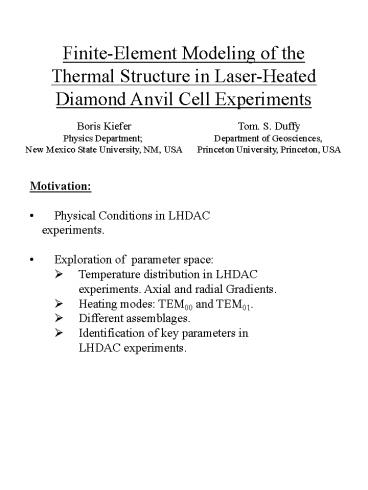Motivation:
1 / 13
Title: Motivation:
1
Finite-Element Modeling of the Thermal Structure
in Laser-Heated Diamond Anvil Cell Experiments
Boris Kiefer Physics Department New Mexico
State University, NM, USA
Tom. S. Duffy Department of Geosciences,
Princeton University, Princeton, USA
- Motivation
- Physical Conditions in LHDAC
- experiments.
- Exploration of parameter space
- Temperature distribution in LHDAC
- experiments. Axial and radial Gradients.
- Heating modes TEM00 and TEM01.
- Different assemblages.
- Identification of key parameters in
- LHDAC experiments.
2
- Previous Work
- Peak temperature is proportional to sample
thickness axial temperature distribution
determined by heat loss through diamonds.(Bodea
and Jeanloz, 1989). - Thermal pressure is non neglegible in LHDAC
experiments 20-30 of the nominal pressure
(Dewaele et al., 1998). - Thermal structure in DAC can cause peak splitting
? apparent phase transitions (Panero and Jeanloz,
2002).
3
Finite Element Modeling of the Thermal Structure
in LHDAC
- Boundary Conditions
- Continuous Temperature across Material
Boundaries. - Continuous Heatflow Between Different Materials.
- Radiative contribution neglected.
4
Computational Strategy
- Complete thermal structure.
- Steady State calculations.
- Cylindrical symmetry (2-d).
- Code FlexPDE (PDE Solutions Inc.)
Heat Conduction Equation
5
Geometry
Heating Laser
Diamond
Argon
Sample
Gasket
Al2O3
Diamond
T(r,z) in Sample and Insulating Medium
Temperature
Argon
Sample
Al2O3
T (1000K)
hG30µm hS15µm (SF 50) h(Al2O3)7.5µm TEM00
mode
6
Sample Filling and Temperature Distribution
Optically thin sample l gtgt hs and kS/kPM
10 Gasket thickness 30 µm TEM00 heating mode
Axial
Filling 10 25 50 75 90 100
Radial
7
Analytical Model for Optically Thin Samples
Boundary conditions T(hG/2) T(-hG/2) 300 k
T0
TM maximum temperature. T0 background
temperature. kS cS/T and kM cM/T
8
Laser Heating Mode and Temperature Gradients
TEM00 TEM01
9
Analytical Prediction of the Axial Temperature
Gradient
?TTmax - T(r0,zhS/2)
Temperature Drop (K)
10
Axial Temperature Gradient and Sample Geometry -
I
Reference Calculation 800 K External Heating
Al support (2.5 µm thick) Single-sided Fe
platelet (1 µm thick)
Optically thin sample l gtgt hs and kS/kPM
10 TEM00 heating mode
Sample Filling 50 hG 30 µm
11
Axial Temperature Gradient and Sample Geometry -
II
Sample Filling 50 hG 30 µm
Double-sided hotplate (2x 1mu Fe-platelets) Microf
urnace (Chudinovskikh and Boehler 2001)
Optically thin sample l gtgt hs and kS/kPM
10 kc/T TEM00 heating mode
12
- Future Work
- Effect of functional form of the thermal
conductivity. Deviations from k1/T behavior. - Radiative component.
- Combined TEM00 and TEM01 mode. Multi mode
heating. - Time dependent calculations of thermal structure,
equilibration times and indeuced temperature
fluctuations due to laser heating.
13
- Conclusions
- Thermal Structure Depends Most Strongly on the
Thermal Conductivity ratio of sample and
insulating medium. - Sample Filling has an Equally Strong Effect on
the Thermal Structure. - Microfurnace assemblage and double-sided
hotplate technique appear to be most promissing. - FE-modeling can be an important tool for the
design and the analysis of LHDAC - experiments.































